Research News
- Honeycreepers may be making a Big Island comeback
- Vog-asthma link unclear in Big Island study
- Technique could improve invitro fertilization success
- Molokaʻi program trains archaeology aides
- Numb3rs flocks to UH theorist
- Hawaiian bibliograpy honored
- Plant migration is factor in climate change
- Beneficial guests worm their way into College Hill
- Beware the banana moth
- Dense, temporary plankton layer intrigues scientists
- Firm licensed to develop UH nanobiosensor
- Astronomer scores firsts on gamma-ray bursts
- Projects receiving recent grants
Honeycreepers may be making a Big Island comeback
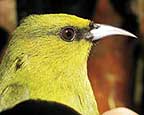
University of Hawaiʻi at Hilo Assistant Professor Patrick Hart took particular pleasure when he heard a distinctive bird trill in his backyard, located in the Big Island’s Hawaiian Paradise Park subdivision.
The call was further confirmation of his research indicating the ʻamakihi and ʻapapane honeycreepers are making a comeback in lower elevations. Bird counts indicate a significant population increase in lower Puna compared to a decade ago.
The reason may be a developed resistance to the deadly avian malaria that has decimated native bird populations, but regeneration of ʻōhiʻa and other host trees on former grazing land and the bird’s possible adaptation to live in non-native trees could also be factors.
topVog-asthma link unclear in Big Island study
More than one-fourth of the 2,000 Big Island children participating in a three-year study of environmental exposures, symptoms and lung function reported having a doctor tell them they have asthma. But don’t blame the vog. There’s a stronger correlation between asthma and environmental tobacco smoke than with recent levels of volcanic air pollution. In fact, researchers found a higher prevalence of physician-diagnosed asthma on the windward side of the Big Island, the area that has the least vog, says Elizabeth Tam, a John A. Burns School of Medicine pulmonologist.
Asthma rates appear to be higher in communities where there’s smoking at the children’s homes—a factor families can control more easily than the tons of sulfur dioxide that Kilauea volcano has pumped into the atmosphere daily since 1992–93, when these children were born.
Tam will examine the role of molds, pollens, pets, nutrition and activity as possible triggers of respiratory disease in continued research funded by the National Institutes of Health and the American Lung Association of Hawaiʻi. So stay tuned.
topTechnique could improve invitro fertilization success
Research at UH’s Institute for Biogenesis Research indicates that removing the acrosome from sperm improves the success of fertilization by intracytoplasmic sperm injection, known as ICSI.
The acrosome, a cap-like structure over the head of sperm, contains enzymes that help sperm penetrate an egg. Removing the acrosome prior to sperm injection increases the successful development of fertilized eggs.
The research was done at IBR by Director Ryuzo Yanagimachi, who pioneered the ICSI fertilization technique in 1976, and Japanese obstetrician Kazuto Morozumi and published in the Oct. 4, 2005, issue of the Proceedings of the National Academy of Sciences.
topMolokaʻi program trains archaeology aides
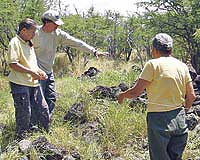
Twenty Molokaʻi residents documented agricultural terraces and possible habitation and religious structures on their island last year while mastering the skills needed to work as archaeological field technicians. Participants in the innovative training program surveyed agricultural systems, used global positioning and other mapping instruments and conducted test excavations in Wailau Valley and in the lower valley and along the western ridge above Kamalō stream.
The two-year program was funded by the Molokaʻi Rural Development Program and conducted by Mānoa archaeologists in partnership with the Society for Molokaʻi Archaeology, Maui Community College’s Molokaʻi Education Center and Kamehameha Schools.
UH Mānoa archaeology doctoral candidates Windy McElroy and Theresa Donham provided instruction. Participants have found work with the National Park Service and private consulting firms on Maui and Molokaāi, where they help survey the rich array of archaeological sites as required by the state prior to development.
topNumb3rs flocks to UH theorist
A Mānoa speech professor’s theory of group dynamics appears in an unusual medium: the CBS show Numb3rs. The program is about an FBI agent who recruits his mathematical genius brother to help solve challenging crimes. It is based on real FBI cases and legitimate theoretical constructs.
When the FBI is baffled by how meth labs thwart government attempts to shut them down, the genius brother quotes Devan Rosen’s emerging "Flock Theory." According to Rosen, groups self-organized from the bottom up tend to be more self-directed, creative and imaginative, therefore more capable of weathering anticipated and unforeseen changes.
"Watch a flock of birds flying, and you notice that they fly as individuals and at the same time as one," he says. "There is no lead bird, no captain or president, yet there is organization, communication, cooperation and shared direction." The same applies to musicians who create complex melodies while jamming. The dynamics that cause this efficient group behavior form the basis of Flock Theory.
As for the meth labs in Numb3rs—eliminate one bird from a flock or fish from a school and the rest learn, adjust and go on with their business. "The process is at once seemingly random and chaotic and at the same time beautifully coordinated and extremely efficient," Rosen says. "Think what we could do if task groups, companies or nations could operate like that. It’s both amazing and hopeful."
topHawaiian bibliograpy honored
The American Library Association History Section named a work by Honolulu Community College Lecturer Richard Lightner the outstanding book-length English language bibliography in the field of history for 2003–04.
Lightner’s Hawaiian History: An Annotated Bibliography contains 2,000 annotated entries for books, articles, dissertations, manuscripts and archival collections on the history and archaeology of Hawaiʻi, pre-Western contact to present. It is part of Greenwood Publishing Group’s Bibliographies of the States of the United States series.
topPlant migration is factor in climate change
Plant populations can migrate through local or long-distant dispersal of seeds that germinate, grow and reproduce. Yet few global-scale ecosystem models incorporate migration of plant populations in predicting the effects of climate change. That’s a problem, because changing vegetation has the potential to either ameliorate (by uptake of excess carbon) or exacerbate (through extinctions that reduce adaptability) the effects of climate change.
University of Hawaiʻi at Mānoa Associate Professor of Botany Josť Fragoso was part of an international team of academic and government scientists who addressed the matter in the September 2005 issue of the journal BioScience. They propose incorporating plant migration into dynamic global vegetation models that merge distribution of vegetation with ecosystem processes, such as carbon, water and nutrient cycles.
The challenge is obtaining adequate data about representative plants’ migratory abilities and factoring in variables such as loss of species, impact of invasive species and sudden changes in the biosphere. The danger is that plants may not be able to migrate quickly enough to keep pace with the increased rate of climate change, which could have serious consequences on availability of timber, water and other resources important to humans.
top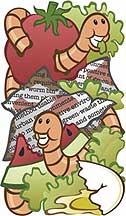
Beneficial guests worm their way into College Hill
The University of Hawaiʻi’s presidential residence has new permanent guests, but they take little room, make no noise and are happy to eat leftovers. They’re a colony of skinny red composting worms who quietly spend their days and nights in a black plastic stacking bin, consuming food scraps and newspapers.
First Lady Wendie McClain discovered Waikīkī Worm Co. at UH Mānoa’s Earth Day fair last year. Maintenance is easy, she says—just tuck over-ripe tomatoes, watermelon rinds, egg shells and other food scraps under the layer of damp newspaper and mist occasionally with water. Drain accumulated liquid for a great plant spray and occasionally collect the resulting vermicast to use as a soil amendment.
The system is odorless and pest-free, McClain says. Waik?=k?= Worm owner and former lawmaker Mindy Jaffe says the average family generates 4 pounds of food waste a week, so a worm bin in just 5,000 homes could divert 520 tons from the waste stream each year. She sells commercial systems, or make one using your own plastic containers and instructions from the College of Tropical Agriculture and Human Resources’ Cooperative Extension Service free publications website. Select "home garden" at and click on "Small-Scale Vermicomposting."
topBeware the banana moth
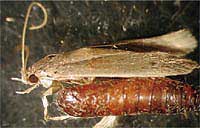
Its common name may be banana moth, but its voracious appetite is proving fatal to coconut and some popular loulu or Pritchardia palms on Oʻahu and the Big Island. Opogona sacchari also has a taste for sugar cane buds as well as banana, pineapple, coffee and other plants.
The damage is done by the larvae, which bore into the tissue, pupate and produce adult moths in as little as 45 days. Because plants under stress are more susceptible to attack, University of Hawaiʻi at Mānoa plant protection scientists recommend keeping your palms well watered and fertilized and avoiding injury through herbicide use, excessive pruning or careless weed-whacking.
Judicious use of an appropriate insecticide can help—contact your nearest Cooperative Extension Service office for advice. To learn more about the moth, select "Insect Pests" at free publications website.
topDense, temporary plankton layer intrigues scientists
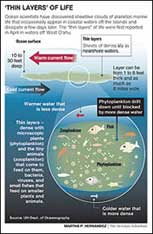
Thin layers of water that are dense with plankton and microbes have been observed in Hawaiian waters. Like sheets of fabric-as diaphanous as lace or opaque as denim-they can form at the bottom of a warm surface current skimming across an opposite-flowing colder current.
Studied over the past decade off the West Coast, the layers have only recently been observed in waters off Oʻahu. They can form a band 1- to 8-foot thick and extend horizontally up to eight miles. They can be dense enough to show up on sensitive sonar, then dissipate within a matter of days.
While the layer persists, the plankton provide a virtual all-you-can-eat smorgasbord, accelerating the interaction of sea life, says University of Hawaiʻi at Mānoa oceanographer Margaret McManus, who will lead a discussion on the phenomenon at the Ocean Sciences Meeting in Honolulu in February 2006.
topFirm licensed to develop UH nanobiosensor
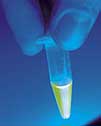
Hawaiʻi based biotechnology firm BioXene has licensed a patent-pending biosensor technology from the University of Hawaiʻi for commercial development.
The nanobiosensor technology developed by UH Mānoa Professor of Molecular Biosciences and Bioengineering Wei Wen Su can be used to speedily detect biological agents, such as proteins, viruses, antibodies and toxic chemicals, in liquids. Potential applications include test kits that could replace current tests for infectious diseases such as flu and tuberculosis and bioterrorism threat agents such as anthrax spores.
topAstronomer scores firsts on gamma-ray bursts
Astronomers have long known that short gamma-ray bursts exist, they just didn't know where they came from.
Tipped off when a NASA satellite detected a half-second burst in July 2005, Paul Price of the University of Hawaiʻi at Mānoa’s Institute for Astronomy and former IfA Post Doctoral Researcher Kathy Roth directed the Gemini telescope in time to monitor the resulting shock wave. The data allowed them to calculate the source—a small galaxy 1.3 billion light years away, where a dense, dead neutron star likely collided with another neutron star and was torn apart as both were sucked into a black hole.
Price was also on call when NASA detected a longer gamma-ray burst early Sept. 4, 2005. He, UH Astronomer Lennox Cowie and Japanese colleagues used the Subaru and IRTF telescopes on Mauna Kea and MAGNUM telescope on Haleakalā to collect visible and infrared images of what turned out to be the most distant of such events recorded to date. Generated by the death of a massive star, the burst was bright enough to provide a glimpse into the dark fringe of the known universe.
topProjects receiving recent grants
- Kilo Nalu, an underwater ocean observing system to be built off Kakaʻako to understand the physical, chemical and biological processes at work where waves and currents interact with reefs and sand beds.
- Testing of a vaccine for West Nile virus to see if it can prevent spread of the disease to nēneē, the endangered Hawaiian goose, with support from ʻAiea-based pharmaceutical firm Hawaiʻi Biotech, which received National Institutes of Health funds to develop vaccines for West Nile virus and dengue fever.
- A "dashboard" project to develop a more comprehensive set of indicators for strategic planning related to the travel industry in Hawaiʻi, with start-up funds from the Hawaiʻi Hotel and Lodging Association matched by the University of Hawaiʻi at Mānoa and its School of Travel Industry Management.